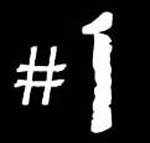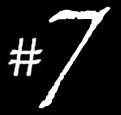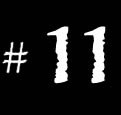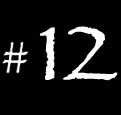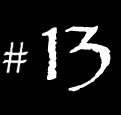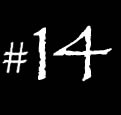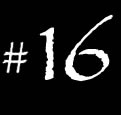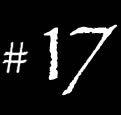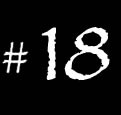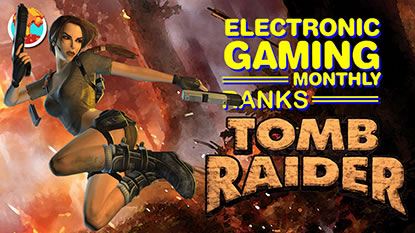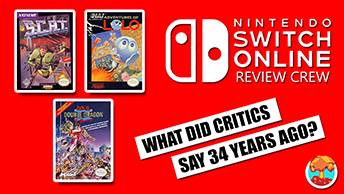- CLASSIC MAGAZINES
- REVIEW CREW
A show recapping what critics thought back
when classic games first came out! - NEXT GENERATION'S BEST & WORST
From the worst 1-star reviews to the best
5-stars can offer, this is Next Generation! - NINTENDO POWER (ARCHIVE)
Experience a variety of shows looking at the
often baffling history of Nintendo Power! - MAGAZINE RETROSPECTIVE
We're looking at the absolutely true history of
some of the most iconic game magazines ever! - SUPER PLAY'S TOP 600
The longest and most ambitious Super NES
countdown on the internet! - THEY SAID WHAT?
Debunking predictions and gossip found
in classic video game magazines! - NEXT GENERATION UNCOVERED
Cyril is back in this spin-off series, featuring the
cover critic review the art of Next Generation! - HARDCORE GAMER MAGAZING (PDF ISSUES)
Download all 36 issues of Hardcore Gamer
Magazine and relive the fun in PDF form!
- REVIEW CREW
- ELECTRONIC GAMING MONTHLY
- ELECTRONIC GAMING MONTHLY RANKS
From Mario to Sonic to Street Fighter, EGM
ranks classic game franchises and consoles! - ELECTRONIC GAMING MONTHLY BEST & WORST
Counting down EGM’s best and worst reviews
going year by year, from 1989 – 2009! - ELECTRONIC GAMING BEST & WORST AWARDS
11-part video series chronicling the ups and
downs of EGM’s Best & Worst Awards!
- ELECTRONIC GAMING MONTHLY RANKS
- GAME HISTORY
- GAME OVER: STORY BREAKDOWNS
Long-running series breaking down game
stories and analyzing their endings! - A BRIEF HISTORY OF GAMING w/ [NAME HERE]
Real history presented in a fun and pithy
format from a variety of game historians! - THE BLACK SHEEP
A series looking back at the black sheep
entries in popular game franchises! - INSTANT EXPERT
Everything you could possibly want to know
about a wide variety of gaming topics! - FREEZE FRAME
When something familiar happens in the games
industry, we're there to take a picture! - I'VE GOT YOUR NUMBER
Learn real video game history through a series
of number-themed episodes, starting at zero! - GREAT MOMENTS IN BAD ACTING
A joyous celebration of some of gaming's
absolute worst voice acting!
- GAME OVER: STORY BREAKDOWNS
- POPULAR SHOWS
- DG NEWS w/ LORNE RISELEY
Newsman Lorne Riseley hosts a regular
series looking at the hottest gaming news! - REVIEW REWIND
Cyril replays a game he reviewed 10+ years
ago to see if he got it right or wrong! - ON-RUNNING FEUDS
Defunct Games' longest-running show, with
editorials, observations and other fun oddities! - DEFUNCT GAMES QUIZ (ARCHIVE)
From online quizzes to game shows, we're
putting your video game knowledge to the test!- QUIZ: ONLINE PASS
Take a weekly quiz to see how well you know
the news and current gaming events! - QUIZ: KNOW THE GAME
One-on-one quiz show where contestants
find out if they actually know classic games! - QUIZ: THE LEADERBOARD
Can you guess the game based on the classic
review? Find out with The Leaderboard!
- QUIZ: ONLINE PASS
- DEFUNCT GAMES VS.
Cyril and the Defunct Games staff isn't afraid
to choose their favorite games and more! - CYRIL READS WORLDS OF POWER
Defunct Games recreates classic game
novelizations through the audio book format!
- DG NEWS w/ LORNE RISELEY
- COMEDY
- GAME EXPECTANCY
How long will your favorite hero live? We crunch
the numbers in this series about dying! - VIDEO GAME ADVICE
Famous game characters answer real personal
advice questions with a humorous slant! - FAKE GAMES: GUERILLA SCRAPBOOK
A long-running series about fake games and
the people who love them (covers included)! - WORST GAME EVER
A contest that attempts to create the worst
video game ever made, complete with covers! - LEVEL 1 STORIES
Literature based on the first stages of some
of your favorite classic video games! - THE COVER CRITIC
One of Defunct Games' earliest shows, Cover
Critic digs up some of the worst box art ever! - COMMERCIAL BREAK
Take a trip through some of the best and
worst video game advertisements of all time! - COMIC BOOK MODS
You've never seen comics like this before.
A curious mix of rewritten video game comics!
- GAME EXPECTANCY
- SERIES ARCHIVE
- NINTENDO SWITCH ONLINE ARCHIVE
A regularly-updated list of every Nintendo
Switch Online release, plus links to review! - PLAYSTATION PLUS CLASSIC ARCHIVE
A comprehensive list of every PlayStation
Plus classic release, including links! - RETRO-BIT PUBLISHING ARCHIVE
A regularly-updated list of every Retro-Bit
game released! - REVIEW MARATHONS w/ ADAM WALLACE
Join critic Adam Wallace as he takes us on a
classic review marathon with different themes!- DEFUNCT GAMES GOLF CLUB
Adam Wallace takes to the links to slice his way
through 72 classic golf game reviews! - 007 IN PIXELS
Adam Wallace takes on the world's greatest spy
as he reviews 15 weeks of James Bond games! - A SALUTE TO VAMPIRES
Adam Wallace is sinking his teeth into a series
covering Castlevania, BloodRayne and more! - CAPCOM'S CURSE
Adam Wallace is celebrating 13 days of Halloween
with a line-up of Capcom's scariest games! - THE FALL OF SUPERMAN
Adam Wallace is a man of steel for playing
some of the absolute worst Superman games! - THE 31 GAMES OF HALLOWEEN
Adam Wallace spends every day of October afraid
as he reviews some of the scariest games ever! - 12 WEEKS OF STAR TREK
Adam Wallace boldly goes where no critic has
gone before in this Star Trek marathon!
- DEFUNCT GAMES GOLF CLUB
- DAYS OF CHRISTMAS (ARCHIVE)
Annual holiday series with themed-episodes
that date all the way back to 2001!- 2015: 30 Ridiculous Retro Rumors
- 2014: 29 Magazines of Christmas
- 2013: 29 Questionable Power-Ups of Christmas
- 2012: 34 Theme Songs of Christmas
- 2011: 32 Game Endings of Christmas
- 2010: 31 Bonus Levels of Christmas
- 2009: 30 Genres of Christmas
- 2008: 29 Controls of Christmas
- 2007: 34 Cliches of Christmas
- 2006: 33 Consoles of Christmas
- 2005: 32 Articles of Christmas
- 2004: 31 Websites of Christmas
- 2003: 29 Issues of Christmas
- 2002: 28 Years of Christmas
- 2001: 33 Days of Christmas
- NINTENDO SWITCH ONLINE ARCHIVE
- REVIEW ARCHIVE
- FULL ARCHIVE
Defunct Games Golf Club Round 3
Welcome back to the Defunct Games Golf Club. Adam Wallace has returned to the links to slice his way through another 18 classic golf games. Experience nearly 40 years of interactive golf as we play through games on the Odyssey 2, Atari 2600, Nintendo Entertainment System, Sega Master System, Genesis, Super NES, PlayStation 2 and more. It's the most exciting set of golf games yet, and you can join in every Friday between May 11 and September 14. That's 18 straight weeks of games based on the game of kings. Fore!

Hello, and welcome to Round 3 of the Defunct Games Golf Club. As with the last two years, I'm looking at eighteen video games of golf spanning eighteen different consoles. Despite the connecting theme of golf, all eighteen games are very different from each other, and that's the advantage golf has over other sports in video game form. Golf can be as realistic or as crazy as developers want without damaging the fundamental gameplay of the sport. Even putt-putt can have that virtual advantage. Unfortunately, the Atari 2600 wasn't fit for going too far in either direction. That console can only really deliver the essentials, but I know it can still do better than Miniature Golf, EVEN in 1979. [READ FULL REVIEW]

One of the great things about doing these retro reviews is getting the chance to try out game systems that I missed when I was a kid. I only had experience with the Atari 2600 and Intellivision back in the day. However, in the last few years, I got to play around with the ColecoVision, Atari 5200, and even the Vectrex. Now, for the Defunct Games Golf Club, I'm getting to try another one as I take on one of the three games simply called Golf that released for the ZX Spectrum (which I'm calling "Virgin Golf" for the sake of clarity). [READ FULL REVIEW]

When I reviewed Golfamania on the Sega Master System the first year of the Golf Club, a comment online questioned my claim that it was the best golf game of the third console generation. I was directed toward another Sega Master System game called World Class Leader Board as a contender for that title. After finally getting around to playing it, I have two questions to answer. Is it a great third-gen golf game? Yes. Is it better than Golfamania? Yes and no. If there's one thing in which World Class Leader Board wipes the floor with Golfamania, it's the options. Unlike the single course Golfamania provided, World Class Leader Board provides four distinct courses as well as a driving range and putting green. Three of the courses are digital recreations of real locations ... [READ FULL REVIEW]

As much as people may enjoy picking on Electronic Arts nowadays, it's easy to forget that the publisher was the golden child back in the 90s. That was especially true when it came to their releases for the Genesis. While they were putting some amazing realistic sports games on Sega's 16-bit machine (more so than on the Super Nintendo), they also took chances with some off-kilter ideas like the Mutant League games. While EA was kicking ass at the time, that doesn't make them completely immune to screw-ups. Zany Golf was one of those screw-ups. At first glance, I thought Zany Golf was a sequel to Putt & Putter (which I reviewed on Game Gear last year). Like that game, Zany Golf is an isometric miniature golf game. Fortunately, the nine holes present here are more creative than the ones Putt & Putter offered. [READ FULL REVIEW]

Since I started this annual marathon of golf games two years ago, I had not been lucky with the golf games I tried on the TurboGrafx-16. Jack Nicklaus' Turbo Golf had lofty ambitions but fell apart due to a clumsy interface and glacial pacing. Power Golf had a nearly impossible course that severely tested my patience coupled with mechanics designed to induce rage. I was about to give up all hope of finding a golf game worth playing on NEC's machine. However, it turns out I just had to look to Japan for the answer, that being Naxat Open. Don't be scared off by the Japanese text on the main menu; the rest of the game is in English and completely playable. [READ FULL REVIEW]

In the late 80s and early 90s, it seemed like there were lots of great games that few Americans knew about at the time as those games never left Japan. I'm definitely seeing that with some of the golf games I'm covering on the third and fourth generation consoles. Naxat Open managed to renew my hope for the TurboGrafx-16 after the very poor games I previously covered on the system. After the utter nightmare of Links: The Challenge of Golf, finding a game as competent as Dynamic Country Club on the Sega CD was as miraculous as scoring a double eagle on the world's longest Par 5. [READ FULL REVIEW]

Thanks to the Defunct Games Golf Club, I'm learning to trust whenever Gremlin Interactive makes a golf game. They made the Saturn's best golf game, VR Golf '97, which I reviewed during the fist season. However, as it turns out, they started making golf games even earlier than that. They created Greg Norman's Golf Power on the Nintendo Entertainment System four years before that one, and never have I been more pleased and angered in equal measure by a golf game than with this one. Step aside, Chip Shot and World Class Leader Board. We have a new champion in terms of 8-bit golf games with the most features. Hell, the feature set for Golf Power even puts many 16- and 32-bit golf games to shame! [READ FULL REVIEW]

You know how some of the dumbest, most unwatchable movies ever made got excused just because they were kids' movies or chick flicks? That also tended to happen during the first generation of portable consoles. Third-parties developing for the Game Boy, Lynx, and Game Gear many times were convinced that people would be so enthralled with being able to play on the go that they'll ignore any issues that came up. "Graphical issues? Lacking content? What do you expect? It's a portable." That definitely seemed to be Telegames' thinking when it came to making Krazy Ace Miniature Golf. When I first loaded up this game, I was initially encouraged. The visuals were bright and colorful. [READ FULL REVIEW]

As we have seen with other golf games I've played in the Defunct Games Golf Club, nothing pisses me off more than a game that's half-assed, especially when it comes to content. If even a golf game on the Intellivision (like Chip Shot) can provide plenty of reasons to return to the game, there's absolutely no excuse for games from the fourth console generation to skimp. Even though I have been angered by content-lacking golf games in the past, one of the worst I had played so far in that regard is an obscure Super Nintendo game called Mecarobot Golf. I had reason to be encouraged at the start. The robot on the cover looked neat, and the game was published by Toho, the same company responsible for Godzilla and all the kaiju that battle him. [READ FULL REVIEW]

Golf is a game that can easily be screwed up on a portable console. With all the information that has to be provided to the player to make the game easy to play, it can be overbearing when you have limited screen area. Awesome Golf on the Atari Lynx showed the best way to display traditional golf on a handheld, and Fred Couples Golf on the Game Gear showed the worst way. Scratch Golf falls in the middle of that spectrum. Scratch Golf made a very good first impression. The visuals are some of the best I had seen on the Game Gear. The colors are vivid, and the two challenging courses show very impressive levels of detail. While the interface is more text-based than Awesome Golf, it doesn't reach the "painful to look at" levels of Fred Couples Golf. [READ FULL REVIEW]

There used to be a time when Sports Illustrated was THE authority when it came to sports, even more so than ESPN. Nowadays no one brings that magazine up except for when Kate Upton makes the cover of the annual swimsuit issue. However, in the mid-90s, a few sports games got the Sports Illustrated license, primarily on the Game Boy. While too many licensed sports games had a real problem with just "phoning it in", Sports Illustrated Golf Classic put in the time and effort to produce a great portable golf game. Like with the pro licenses on the Intellivision's sports games, the Sports Illustrated license doesn't really add anything to the game aside from marketability. Fortunately, the game provides enough content to make you overlook the superfluous license. There are two challenging fictitious courses that don't go so overboard that they become unfair. [READ FULL REVIEW]

The Sega Saturn was one of the most import-friendly consoles of the era. Ever since getting an Action Replay to plug into the expansion slot, my girlfriend and I have been steadily adding Japanese games to our Saturn collection. I wasn't expecting to find an import golf game for the system, but I stumbled across Masters: Haruka Naru Augusta 3 at a retro game store for dirt-cheap. After playing it, I can safely say that I wouldn't have paid full price for it if I had to. As can be gleaned from the first word of the title, this game focuses on the Masters Tournament, one of the biggest annual events in pro golf which takes place at Augusta National Golf Club on the first week of April every year. Naturally, with that focus, I'm not surprised that Augusta is the only course represented on the disc. [READ FULL REVIEW]

During the first round of the Golf Club, one of the most pleasant surprises was when I reviewed VR Golf '97 on the Saturn. The visuals pushed the Saturn, and the gameplay was very solid. My only lament at that time was the limited amount of content. Looking up, I discovered that that game was the first entry in a European series called Actua Golf. To my delight, I learned that, while Actua Golf 3 stayed in the UK, Actua Golf 2 released in America as Fox Sports Golf '99. After hunting it down, I was sure that I would be giving it the "A" that I wanted to give the first game so much. After playing it, I'm disappointed to say that's not happening. Just looking at the options got me ecstatic. Unlike the first game which only had four character skins to choose from, this one features a character creator with a decent number of options for tailoring your player's look. [READ FULL REVIEW]

I'm getting a real sense of deja vu here. Last year, I covered Pocket Golf, an imported Japanese golf game for the Game Boy. It was in black-and-white, featured cute chibi characters, had only one course, and was so easy to play that it took actual effort to screw up a hole. I saw all of that all over again when I played Nice On on the Bandai WonderSwan. While there are some differences, I wouldn't be at all surprised if Aisystem Tokyo borrowed Bottom Up's design notes from the prior game. Despite being monochrome as well, the WonderSwan was a more powerful portable than the basic Game Boy, and Nice On does show that off. The characters are much better detailed, and the animation is extremely smooth. The course has a lot of detail, and I like the little pictographs used for the results of certain shots. [READ FULL REVIEW]

If nothing else can be said about Nintendo, you could say that they're very practical. Camelot had a massive success developing the original Hot Shots Golf for Sony to put on the original PlayStation. Naturally, Nintendo called them up and asked them to do the same thing for the Nintendo 64, even letting them use the Big N's most popular characters. This collaboration produced the original Mario Golf, and, while I will admit that I am a little spoiled by the creativity present in the GameCube sequel, I still find the first game to be an enjoyable time on the links that has held up quite well. Like with the PlayStation game, Mario Golf is chock-full of content. In fact, it actually provides more bang for the buck than Hot Shots. [READ FULL REVIEW]

It's always a risky proposition to release a game that requires a special peripheral. Too often that combination results in a higher price and increased difficulty in selling it. On top of that, quality can be very uneven. It doesn't matter how good the game is if the peripheral required to play it is an unreliable piece of crap. Steel Battalion on the Xbox is the perfect example of an awesome game with awesome gear, and the combo of Super Glove Ball and the Power Glove for the original Nintendo is at the other end of the spectrum. Real World Golf and its GameTrak controller are smack dab in the middle. The GameTrak is a weird-looking device that connects to one of the rarely-used USB ports on the PlayStation 2. The sizeable hunk of plastic has two cables with finger-less gloves at the end and a foot pedal to serve as the "accept" button. [READ FULL REVIEW]

Remember when I reviewed CyberTiger for the Nintendo 64 during the first round of the Golf Club? Remember how that game tried to cater to both casual and serious golf fans while also introducing the analog swing mechanics? By the end of my playtime with that game, while I was pleased with how well the analog swing worked, I found myself wishing they chose one audience or the other. Apparently Telenet Japan got that memo as they took the analog swing and put it in a game purely for the casual market. The result is Swingerz Golf, and this is the closest we will ever see to a Hot Shots Golf game without the three-click mechanics. While a lot of games with analog swings that came out during the sixth generation or later tended to have controls that were sensitive to the point of frustration, Swingerz Golf managed to keep things easy. [READ FULL REVIEW]

Well, it's the end of the road for Round 3 of the Defunct Games Golf Club. Thank you once again for joining me for this journey through the history of golf games, and I hope you'll join me next year for the Final Round. Back in the first round of the Golf Club, I fired quite a few shots at Links: The Challenge of Golf on the Sega CD. To this day, I still consider it the worst golf game I ever played. Fortunately, new developers and Microsoft took over the series and steered it back on course, culminating with Links 2004, the best thing to be linked to Microsoft's short-lived XSN Sports banner. It's clear that the developers were huge fans of the Tiger Woods PGA Tour franchise as this game does rip off that series rather blatantly. The career mode is very similar with tournaments and some annoying special challenges parsed out, a large supply of official gear to use, and winnings being used to buy skill points to upgrade your custom golfer. [READ FULL REVIEW]
Still can't get enough golf? Then you might enjoy the first season of Defunct Games Golf Club. Join Adam as he plays through 18 holes, including Links: Challenge of Golf, CyberTiger, Hot Shots Golf, 36 Great Holes Starring Fred Couples, Ninja Golf, Awesome Golf, Lee Trevino's Fighting Golf and more!
#1: Golf (Atari 2600)
#2: Chip Shot: Super Pro Golf (Intellivision)
#3: Lee Trevino's Fighting Golf (NES)
#4: Golfmania (Master System)
#5: Ninja Golf (Atari 7800)
#6: Itchy & Scratchy in Miniature Golf Madness (Game Boy)
#7: Awesome Golf (Lynx)
#8: Fred Couples Golf (Game Gear)
#9: Jack Nicklaus: Turbo Golf (TurboGrafx-16)
#10: PGA Tour Golf III (Genesis)
#11: Links: The Challenge of Golf (Sega CD)
#12: 36 Great Holes Starring Fred Couples (32X)
#13: Kirby's Dream Course (Super NES)
#14: Neo Turf Masters (Neo Geo)
#15: VR Golf '97 (Saturn)
#16: Hot Shots Golf (PlayStation)
#17: CyberTiger (Nintendo 64)
#18: Tee Off (Dreamcast)
Or maybe you're ready to jump over to season 2? Adam tees off on games like Bandai Golf: Challenge Pebble Beach, Great Golf, Mean 18, Power Golf, Putt Putter, Final Round Golf 2002, Pro 18, Mario Golf: Toadstool Tour, Outlaw Golf 2 and more!#2: Chip Shot: Super Pro Golf (Intellivision)
#3: Lee Trevino's Fighting Golf (NES)
#4: Golfmania (Master System)
#5: Ninja Golf (Atari 7800)
#6: Itchy & Scratchy in Miniature Golf Madness (Game Boy)
#7: Awesome Golf (Lynx)
#8: Fred Couples Golf (Game Gear)
#9: Jack Nicklaus: Turbo Golf (TurboGrafx-16)
#10: PGA Tour Golf III (Genesis)
#11: Links: The Challenge of Golf (Sega CD)
#12: 36 Great Holes Starring Fred Couples (32X)
#13: Kirby's Dream Course (Super NES)
#14: Neo Turf Masters (Neo Geo)
#15: VR Golf '97 (Saturn)
#16: Hot Shots Golf (PlayStation)
#17: CyberTiger (Nintendo 64)
#18: Tee Off (Dreamcast)
#1: Computer Golf! (Odyssey 2)
#2: My Golf (Atari 2600)
#3: PGA Golf (Intellivision)
#4: Bandai Golf: Challenge Pebble Beach (NES)
#5: Great Golf (Master System)
#6: Mean 18 (Atari 7800)
#7: Power Golf (TurboGrafx-16)
#8: Arnold Palmer Tournament Golf (Genesis)
#9: True Golf Classics: Wicked 18 (Super NES)
#10: Pocket Golf (Game Boy)
#11: Putt & Putter (Game Gear)
#12: Final Round Golf 2002 (Game Boy Advance)
#13: PGA Tour '97 (Saturn)
#14: Pro 18: World Tour Golf (PlayStation)
#15: Waialae Country Club: True Golf Classics (Nintendo 64)
#16: Eagle Eye Golf (PlayStation 2)
#17: Mario Golf: Toadstool Tour (GameCube)
#18: Outlaw Golf 2 (Xbox)
Tune in every Friday between May 11 and September 7 for new episodes of the Defunct Games Golf Club Round 3.
#2: My Golf (Atari 2600)
#3: PGA Golf (Intellivision)
#4: Bandai Golf: Challenge Pebble Beach (NES)
#5: Great Golf (Master System)
#6: Mean 18 (Atari 7800)
#7: Power Golf (TurboGrafx-16)
#8: Arnold Palmer Tournament Golf (Genesis)
#9: True Golf Classics: Wicked 18 (Super NES)
#10: Pocket Golf (Game Boy)
#11: Putt & Putter (Game Gear)
#12: Final Round Golf 2002 (Game Boy Advance)
#13: PGA Tour '97 (Saturn)
#14: Pro 18: World Tour Golf (PlayStation)
#15: Waialae Country Club: True Golf Classics (Nintendo 64)
#16: Eagle Eye Golf (PlayStation 2)
#17: Mario Golf: Toadstool Tour (GameCube)
#18: Outlaw Golf 2 (Xbox)
HOME |
CONTACT |
NOW HIRING |
WHAT IS DEFUNCT GAMES? |
NINTENDO SWITCH ONLINE |
RETRO-BIT PUBLISHING
Retro-Bit |
Switch Planet |
The Halcyon Show |
Same Name, Different Game |
Dragnix |
Press the Buttons
Game Zone Online | Hardcore Gamer | The Dreamcast Junkyard | Video Game Blogger
Dr Strife | Games For Lunch | Mondo Cool Cast | Boxed Pixels | Sega CD Universe | Gaming Trend
Game Zone Online | Hardcore Gamer | The Dreamcast Junkyard | Video Game Blogger
Dr Strife | Games For Lunch | Mondo Cool Cast | Boxed Pixels | Sega CD Universe | Gaming Trend
Copyright © 2001-2025 Defunct Games
All rights reserved. All trademarks are properties of their respective owners.
All rights reserved. All trademarks are properties of their respective owners.







